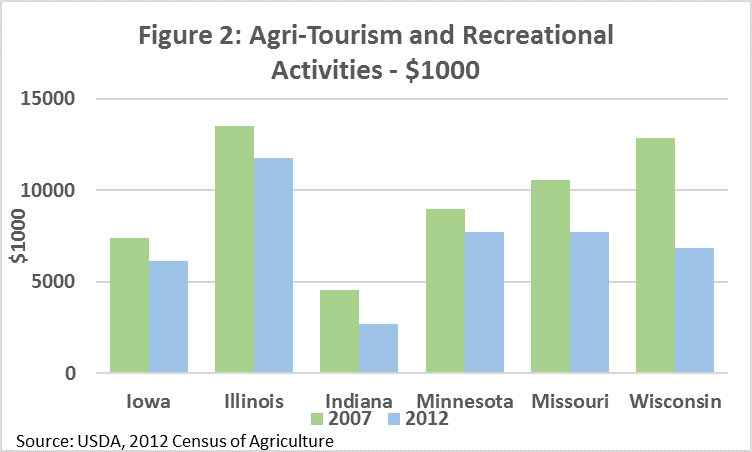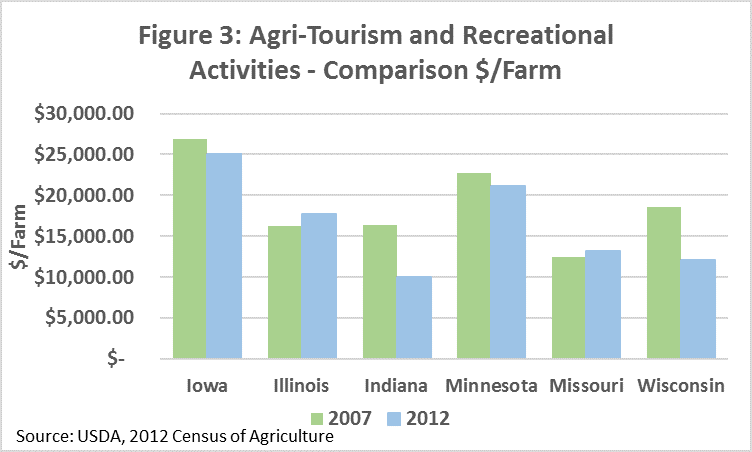A year ago I found a farm that was participating in a worldwide cooperative organic farming program. I worked and stayed on the farm for nearly a week where I would assist on all the farm activities, managing irrigation, manure application, as well as watering and feeding animals. In return, the farm provided a place to stay and farm fresh food to eat, all provided free of charge (other than my labor). There are thousands of farms like this all over the world. Inexpensive farm hands for producers, and farm experience for some who may have never had that opportunity.
 This is one form of agri-tourism that shows the growing interest from the general population in food production and willingness to take time to understand and support it. However, agri-tourism is still a fledgling industry with the challenge of accounting for value because of a lack of reportable data. There is, however, a section within the Census of Agriculture that reports data on the number of farms participating in agri-tourism and recreational services and income received from such activities.
This is one form of agri-tourism that shows the growing interest from the general population in food production and willingness to take time to understand and support it. However, agri-tourism is still a fledgling industry with the challenge of accounting for value because of a lack of reportable data. There is, however, a section within the Census of Agriculture that reports data on the number of farms participating in agri-tourism and recreational services and income received from such activities.
 In the last decade it has become more common to hear about the widespread interest in where food comes from, how it gets from farm to fork, and even how it is grown or raised. However, what does the data say? Are the number of farms participating in these activities increasing? Are more dollars being spent on agritourism? Based on the 2012 US Department of Agriculture’s: Census of Agriculture, the number of farms is generally decreasing and the number of dollars spent is also decreasing. Overall between 2007 and 2012, dollars spent per year on agri-tourism and Recreational Services decreased by $150 million, and the number of farms participating has decreased by about ten thousand. Additionally, although some of the states reported an increase in the number of dollars of income received per farm from agri-tourism, this is not the case for the total of all states. When taken as a whole, the United States decreased in the income received from agri-tourism.
In the last decade it has become more common to hear about the widespread interest in where food comes from, how it gets from farm to fork, and even how it is grown or raised. However, what does the data say? Are the number of farms participating in these activities increasing? Are more dollars being spent on agritourism? Based on the 2012 US Department of Agriculture’s: Census of Agriculture, the number of farms is generally decreasing and the number of dollars spent is also decreasing. Overall between 2007 and 2012, dollars spent per year on agri-tourism and Recreational Services decreased by $150 million, and the number of farms participating has decreased by about ten thousand. Additionally, although some of the states reported an increase in the number of dollars of income received per farm from agri-tourism, this is not the case for the total of all states. When taken as a whole, the United States decreased in the income received from agri-tourism.

Therefore, decreasing amounts of income from agri-tourism could be the result of many factors from decreased knowledge of opportunity to simply the challenge within the industry accurately account for dollars received. In addition, as the Census of Agriculture is only gathered every 5 years, new data will be available in February 2019 and will shed additional light on the topic. As people become more interested in where their food comes from and want to participate in various agricultural activities it will be insightful to learn if this increased awareness is translating into more dollars for agri-tourism operations.
Finally, although there have been overall decreases in agritourism, with the increased interest in recent years, and data that is not up to date, it would not be surprising to see an increase in the years since the last Ag-census. Looking for ways to diversify, and capitalize on the mounting interest of the general population in food production can be a way to add value to your operation. Also increased awareness of day to day agricultural practices and challenges from a more widespread audience will create a more understanding political and economic landscape for farmers in the future.

